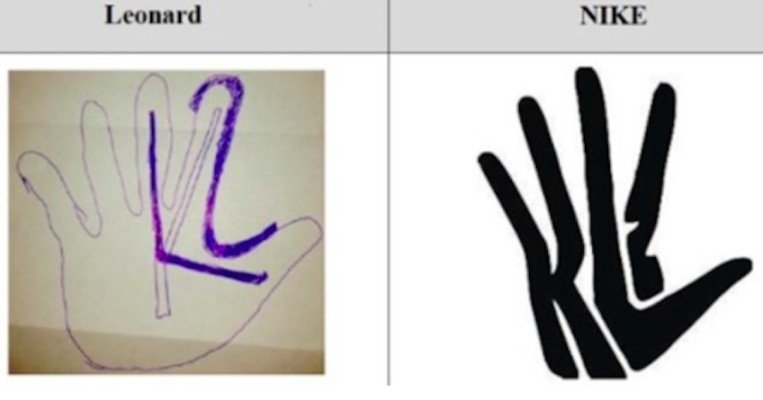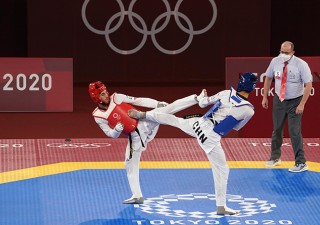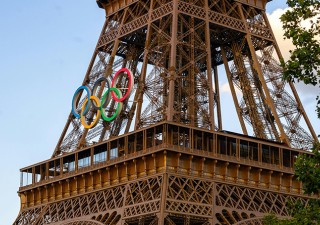Olympics 2024: When fashion brands strike gold
31 July 2024

Photo courtesy of the International Olympic Committee.
“Sports will always be important in global culture, and so fashion, as a reflection of cultural trends, will always incorporate influences from sports” – Giorgio Armani
The countdown to the Paris Olympics began two months ago when the 128-year-old ship Belem docked in Marseille and the Olympic torch on board was carefully unwrapped from its custom-made Louis Vuitton trunk to begin the torch relay on French soil.
French luxury multinational LVMH announced itself as a sponsor of the 2024 Olympic Games only a year ago, but it has been hard at work ever since to ensure that the attention on Paris also trains the spotlight on its own brands ranging from Louis Vuitton (LV), the world’s biggest luxury brand, to jeweller Chaumet and suiting specialist Berluti, which is making the uniforms for the French Olympic team. Millions of bottles of Moët & Chandon champagne and Hennessy cognac are stocked at Olympic hospitality venues. Chaumet has designed the medals which will be stored and presented in custom Louis Vuitton trunks. The awards will be presented on salvers bearing the signature brown LV check and the volunteers bearing the awards will be in Louis Vuitton clothing.
Fashion heavyweights are also behind the uniforms of several other nations including Ralph Lauren for athletes from the United States, Emporio Armani for those from Italy and Tarun Tahiliani for those from India.
However, a couple of weeks before the Games were due to start, the internet had already chosen its favourite national uniform – Mongolia’s. Michel&Amazonka, an Ulaanbaatar-based label producing couture and ready-to-wear garments, took social media by storm with a series of glossy photos featuring intricately embroidered vests, pleated robes and accessories – pouch bags, sash belts, dangling earrings, pointed buryat hats and gutal boots – inspired by traditional attire. Praise came thick and fast for the beautifully designed garments with gold embroidery details featuring fish, mountains and images of nature. Some commentators went so far as to say, “they just won the Olympics before it even started”.
Unlike for previous Olympics, the Paris 2024 opening ceremony will not take place in a stadium. Instead, dozens of boats will carry athletes and performers on a 6-kilometer route along the Seine River. This runway on the water, so to speak, is guaranteed to cause no less a splash than the one caused by LV’s present creative director Pharrell William’s debut fashion show at Pont Neuf, the oldest bridge in Paris, in 2023.
A utlilitarian past
“Sportswear” is clothing worn for playing sport or casual every-day living. From humble beginnings of functionality, this clothing segment has evolved into popular streetwear and high fashion today. The word “athleisure” was added to the Merriam-Webster Dictionary in 2016, defined as “casual clothing designed to be worn both for exercising and for general use”. Statistics show that the global athleisure market was valued upwards of US$350 billion in 2023 and is expected to grow at 9.3 percent annually until 2030. The LVMH-Olympics tie-up highlights fashion’s increasing interest in sport and, according to PwC, the sports-sponsorship market is set to nearly double from US$63 billion in 2021 to US$109 billion by 2030.
In India, the sports apparel market was valued at US$673.34 million in 2022 and is expected to grow more than 16 percent each year to treble in size by 2029.
To capitalize on such significant commercial potential, also being witnessed is the emergence of “ath-couture” where functionality meets high style to shape contemporary trends and consumer preferences. A good example of this would be the synergy sparked by the adidas x Gucci collection in 2022, when the Gucci and adidas logos were combined and featured prominently on men’s and women’s clothing, shoes, bags and other accessories.
Collaborations are a cornerstone
According to the Lyst Index’s Q2 2022 report (the Lyst Index is the industry’s quarterly report that ranks fashion’s hottest brands and products), the adidas x Gucci line helped Gucci dethrone Balenciaga as the world’s hottest fashion brand. The data of another leading brand management tool, Questbrand, showed brand equity bump-ups for both Gucci (+3.7) and adidas (+3.2) following the collaboration. Growth in brand equity translates into growth in sales, which is what makes collaborations so popular. Such associations can also be long term, such as the one adidas has had with British designer Stella McCartney since 2005.
Closer to home, the 2017 limited-edition Christian Louboutin x Sabyasachi capsule collection featured sneakers alongside loafers, sandals, boots and handbags. A couple of years later, popular designer Masaba Gupta teamed up with Puma to create exclusive sneaker designs.
But perhaps the connection between sport and fashion in India more often takes the form of collaborations and endorsement deals between sports brands and athletes. Reportedly, after the 2020 Tokyo Olympic Games, endorsement fees of Indian medalists such as Neeraj Chopra (he won gold for javelin) rose more than 10 times. Indicative of his brand equity is the recent partnership announced in May 2024 with luxury watchmaker Omega, the official timekeeper of the Paris Games. Significantly, Neeraj Chopra is the first Indian track and field athlete to be Omega’s sport brand ambassador. Other Indian brand ambassadors include World Boxing Champion Mary Kom (Puma) and Indian athletics star Hima Das (Adidas).
Coming back to Louis Vuitton, in 2022, it ran an iconic brand campaign featuring Cristiano Ronaldo and Lionel Messi where the two football stars were shown playing a game of chess on the checkerboard canvas of a Louis Vuitton Damier attaché case. In the wake of the advertisement, Ronaldo became the first person to pass 500 million followers on Instagram and, according to the Launchmetrics scoring system that assigns a monetary value to every post, interaction or article about a brand to measure its performance and impact, Ronaldo’s post had a media impact value of US$2.8 million in the first 48 hours. Messi’s post had a value of US$2.6 million, and Louis Vuitton’s post was worth US$1.1 million – a powerful and interesting statistic attesting (in this case) to the higher brand value of sporting icons vis-à-vis an iconic fashion brand.
Legal considerations
Since partnerships between athletes, sports brands and fashion labels are some of the most celebrated forms of brand marketing, it is usual for businesses to protect their brand by way of trademark registrations. In recent years, there has also been a notable increase in the number of athletes trademarking their names. Famous sports personalities such as Serena Williams, Michael Jordan, Usain Bolt, Sachin Tendulkar and David Beckham amongst others all have trademark registrations for their names in different countries. Usain Bolt also has the ‘LIGHTNING BOLT’ gesture registered. Personal branding of athletes has thus increased, highlighting the significant commercial value of their identity. Trademark registrations of one’s name or likeness enables better control over one’s image and smoothens the path to monetization of brand value. For example, curbing unauthorized use that can cause consumer confusion and, ultimately, dilute an individual’s brand value becomes far easier.
Given that we live in a time where markets are global but intellectual property rights are territorial, well-crafted legal strategies are a must when it comes to sponsorships and collaborations. To give an example, civil law countries accord primacy to the person who is the first to file a trademark whilst common law countries, such as India, give primacy to the one who is the first to use the mark. The famous Michael Jordan v. Qiaodan Sports case in China in 2012 illustrates this point well. Basketball legend Michael Jordan sued Qiaodan Sports Company, a Chinese sportswear and footwear manufacturer, alleging unauthorized use of his name and likeness to sell products in China. Qiaodan is the Mandarin translation of Jordan but the Chinese company claimed Qiaodan was a common Chinese name and it had not used Jordan’s name or likeness in a way that would confuse consumers. Despite Jordan not having a registration in China for ‘Jordan’ (which follows a first-to-file system), he was still able to obtain a favourable order on the basis of making a claim that ‘Jordan’ was a well-known brand – thus, knowledge of local laws proved crucial in this case.
Were a similar situation to arise in India, lack of registration would have been a lesser concern for enforcement. However, well-known status for a trademark is not a claim proved easily – substantial evidence of awareness and use among Indian consumers must be put on record. In this context, though registration of a trademark is not mandatory in India to claim trademark rights, it is beneficial as it is prima facie evidence of ownership of one’s brand or mark.
An important lesson also emerges from tennis champion Roger Federer’s dispute with Nike once their collaboration ended in 2018. Federer first sported the “RF” initials at Wimbledon in 2006. He was even involved in the design process himself; however, it was Nike who registered the RF Logo as a trademark in various jurisdictions and thus acquired ownership over it and, in principle at least, the corresponding right to stop third parties, including Federer himself, from using it. Though ultimately Nike assigned the marks back to Federer, ideally, such a situation is easily obviated by including suitable IP clauses in a sponsorship contract.
In fact, be it endorsement arrangements, licensing agreements, ambassadorships or co-branding partnerships, all must clearly spell out the terms of collaboration, securing rights of all parties while obliging performance and setting the tone for the way forward once a collaboration ends. In the absence of such considerations, legal battles are inevitable.
American basketball player Kawhi Leonard sued Nike for copyright infringement after he began to endorse New Balance. Leonard claimed ownership of the ‘Klaw’ logo, which encompassed his initials ‘KL’, jersey number (2) and his large and powerful hands, asserting he designed the logo and shared it with Nike whilst signing an endorsement deal. Nike countersued, stating that the final logo was different and proprietary to Nike. It also submitted Leonard’s admission that Nike had played an instrumental role in transforming his concept into a separate and marketable property. The US District Court of Southern California rejected Leonard's copyright claim and granted a motion confirming Nike’s ownership of the logo. Again, a well-thought agreement prior to signing the endorsement deal between Nike and Leonard, stipulating appropriate terms and pre-empting differing claims over IP upon conclusion of the collaboration, may have turned things differently.

Another example of a complex situation is when an athlete is ambassador or endorser of a particular brand, however, the sport event she or he participates in is sponsored by a competing brand. Such situations ought to be factored in in advance, ensuring fulfilment of contractual obligations, conflicts of interest, and potential reputational considerations, especially in collaborations involving exclusivity. Notably, Rule 40 of the Olympic Charter restricts athletes’ participation in non-official sponsor advertising during the Olympic Games, aiming to protect the exclusivity of the official Olympic sponsors. In the digital age, while still respecting Rule 40, brands often work with athletes on content that highlights their journey, training, and personal stories without directly promoting products during the blackout period.
Sports merchandising
The fashionable ripples of the 2024 Games are being felt 8,000 kilometres away in Tamil Nadu, India, where apparel manufacturer Back Bay India is based. Its products are being readied for sale in official retail outlets in Paris and, considering that the International Olympic Committee (IOC) is targeting total merchandise sales of around €2 billion (US$2.16 billion) through its official channels, Back Bay has its work cut out for it. The €2 billion target indicates how big a business sports merchandising is.
Sports merchandise makes consumers and supporters feel more connected to sporting events, personalities and experiences, which is why all major sporting events such as the FIFA World Cup as well as India’s powerful cricket franchise, the Indian Premier League (IPL), have merchandising as a crucial revenue stream. Selected partners are permitted to sell official merchandise based upon licensing agreements – for instance, the IOC maintains exclusive ownership and control of the use of Olympic Symbols and licenses out its IP rights to manufacturers and sale partners.
Intellectual property rights such as trademarks, designs and copyright are crucial in the realm of merchandising. A team’s name, logo, tagline or anything capable of graphic representation and bearing the ability to play a source-identifying function must be registered as a trademark. Copyright and design protection may also be sought for new and aesthetic designs. A strong IP portfolio with optimized protection assists in mitigating the risk of counterfeiting which poses a significant challenge to the sports merchandising industry.
Made-to-measure
With the Siene cleaned up, the several swimming events scheduled to take place in the river promise to be quite a spectacle. And in the changing rooms, one brand of swim wear – Speedo – will perhaps be the preferred choice again. In 2000, its pioneering Fastskin swimsuit, inspired by the varying skin texture of a shark, with compression and ridges in key areas, improved glide by mimicking nature. Eighty-three percent of swimmers who won a medal at the 2000 Sydney Olympic Games were wearing the Fastskin suit, and so were 13 out of the 15 swimmers who broke world records. As a result, its designer, Fiona Fairhurst, who led the Speedo design team, was shortlisted for the European Patent Office’s European Inventor of the Year award. Speedo launched the Fastskin LZR Racer in 2008 and at the Beijing Olympics later that year, Michael Phelps won a record eight golds in a single Games. In fact, 94 percent of victorious swimmers – and 98 percent of those who won any swimming medal – in Beijing were wearing the latest suit.
Meanwhile, Kenyan runner Hellen Obiri, an Olympic silver medalist, will compete in the Paris Games wearing Cloudboom Strike LS shoes from Swiss footwear brand On. The shoes are made using spray-on technology. Lace-free and weighing less than the latest iPhone, the innovative CloudTec technology cushions the foot and allows a softer landing and better push-off during runs. The company also claims its technology is sustainable as it reduces the carbon emissions of producing a shoe’s upper by 75 percent. At the Tokyo Olympics, few had heard of On, but they are currently selling in more than 60 countries and the company’s sales for 2023 reached £1.5 billion (US$1.93 billion), up 47 percent from 2022. In fact, the brand is also designing the uniform for the 2024 Swiss Olympic Team.
Innovative products – such as the ones discussed above – are the subject matter of patent protection which allows the technology to be sold exclusively by the innovator company in the market for a term of 20 years. Other examples from the sports arena that would qualify for patent protection include wearable tech, such as fitness trackers and smartwatches.
Ready, Get Set, Go
To conclude, as athletes ready to show off their style both on and off the field at the Paris 2024 Games, the event looks set to be thrilling mix of sport and fashion. The classical Greeks and the father of the modern Olympic Games – Pierre de Coubertin – would be pleased for, until 1948, cultural events were historically intertwined with the Games. Also befitting is that as part of France’s “Cultural Olympiad” (a multidisciplinary artistic and cultural programme that will run alongside the Games), sponsor Louis Vuitton is showcasing art related to the Olympic Games in an exhibition titled The Collection, Rendez-Vous with Sport.
About the authors
Radha Khera is an intellectual property, fashion and luxury law attorney at Remfry & Sagar, with more than a decade of legal experience. She joined Remfry & Sagar in 2012 and is adept at conducting brand audits and due diligence for clients, providing opinions on the feasibility of intellectual property protection in India, and assisting with statutory protection and enforcement. She has strong advisory skills in overall brand strategy and protection. Khera is also a qualified fashion lawyer, having completed her second-level Master’s degree in fashion law from Luiss Guido Carli in Rome. She has been trained by counsel of renowned Italian and French fashion houses and is qualified to address legal issues faced by the fashion industry with regard to overall intellectual property protection, corporate transactions and governance, data privacy, advertisement concerns, alternate dispute resolution, issues in the supply chain, sustainability and ESG.
Bisman Kaur leads media outreach, communications and publishing activities at Remfry & Sagar. She is editor of the firm’s newsletter, ensuring clients and associates are kept updated on the latest IP news from India as well as happenings at the firm’s office. She is also the point of contact for events and conferences that the firm participates in throughout the year, including the Remfry’s IP Seminar and the BRICS IP Forum. A trademark attorney, she has extensive experience in advising clients on the adoption and protection of brand names with strong knowledge of the finer nuances of assignment and licensing of trademark rights. Her awareness of trademark law aside, the dual aspects of her practice lend her a deep insight into legal and policy developments across the entire IP spectrum. Kaur has authored numerous articles on varied IP subjects. She also attends IP events and conferences in India and overseas.









